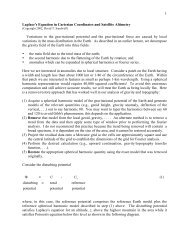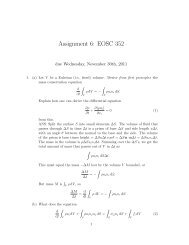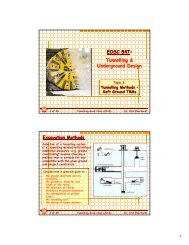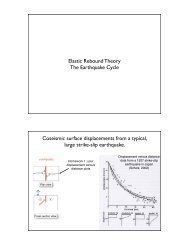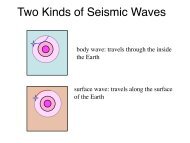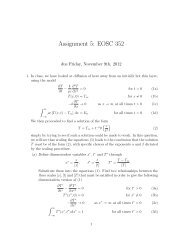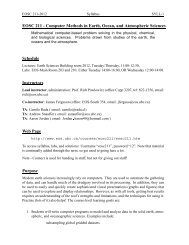Viscosity of magmatic liquids - ResearchGate
Viscosity of magmatic liquids - ResearchGate
Viscosity of magmatic liquids - ResearchGate
Create successful ePaper yourself
Turn your PDF publications into a flip-book with our unique Google optimized e-Paper software.
Author's personal copyD. Giordano et al. / Earth and Planetary Science Letters 271 (2008) 123–134125where A, B and C are adjustable parameters, including the preexponentialfactor, pseudo-activation energy, and the VFT-temperature,respectively. On the basis <strong>of</strong> theoretical and numerical arguments(Myuller, 1955; Eyring et al., 1982; Angell, 1985; Russell et al., 2002,2003) we assume A to be an unknown constant. This implies that thecompositional controls on viscosity reside only in B and C.3.1. The constant A conceptFig. 2. Summary <strong>of</strong> data used to calibrate VFT model for compositional dependence <strong>of</strong>silicate melt viscosity. Data shown as log η vs. 10,000/T(K) for (A) volatile-free, and(B) volatile-rich melts (Sources listed as supporting material in the Appendix). Notevertical axes are equivalent but horizontal axis for (B) has been extended to lowertemperatures.compositional range as the anhydrous dataset (Fig. 1A, B). In the presentanalysis the NBO/T parameter (number <strong>of</strong> non-bridging oxygens pertetrahedra), representing a first order approximation to the degree <strong>of</strong>polymerization <strong>of</strong> the melt, is calculated accordingly to Mysen (1988) byassuming that SiO 2 , TiO 2 , Al 2 O 3 , and Fe 2 O 3 are network formers. For thepurposes <strong>of</strong> NBO/T calculations only, total iron (FeO T ) was split equally(wt.%) between FeO and Fe 2 O 3 (Giordano and Dingwell, 2003; Giordanoet al., 2006); calculated values <strong>of</strong> NBO/T for all melts in the database rangefrom 0 to 1.8.3. Model optimizationThe experimental database comprises only viscosity measurementsthat are coupled to melts for which there are complete andaccurate compositions, including direct analysis <strong>of</strong> volatiles (e.g.,spectroscopic or volumentric). We use the oxide mol% as a chemicalbasis and treat all iron as FeO even though there is evidence that Fe 2 O 3and FeO play distinct roles in governing melt structure (Mysen, 1988)and that the redox state <strong>of</strong> very Fe-rich melts does measurablyinfluence viscosity (Dingwell, 1991). Our redox simplification here ispurely empirical, resulting from the fact that tests for modelimprovement, based on a redox factor, fail to produce an improvement<strong>of</strong> the fit. Fluorine is treated as mol% F 2 O − 1 (Giordano et al., 2004b).Temperature dependence <strong>of</strong> viscosity (η) is modelled by the VFTequation (Vogel, 1921; Fulcher, 1925):The parameter A is the value <strong>of</strong> log η (Pa s) at infinite temperatureand, thus, represents the high temperature limit to silicate melt viscosity(log η ∞ ). The assumption that A is constant for all melts (i.e., independent<strong>of</strong> composition) implies that all melts converge to a single, commonvalue <strong>of</strong> viscosity at high-T. The expectation is that at super-liquidustemperatures, all silicate melts will become highly dissociated <strong>liquids</strong>regardless <strong>of</strong> their lower temperature structure and converge to lowerlimiting value <strong>of</strong> viscosity. The “constant A concept” is supported byobservations on many low-T glass-forming systems including polymermelts (e.g., polyisobutane), organic <strong>liquids</strong> (e.g., Salol and O-terphenyl)and even liquid elements (e.g., molten Se) (Angell, 1991; Scopigno et al.,2003). In these systems, experiments can be run at temperaturesthat are well above the corresponding glass transition temperatures(e.g., T g /T → 0) and, thus, can directly explore the high-T properties <strong>of</strong>melts. These experiments have shown that, at temperatures well aboveT g , both strong and fragile melts commonly converge to a commonviscosity (e.g., η T→∞ ~10 −5 Pa s; e.g., Eyring et al.,1982; Angell,1991,1995;Russell et al., 2003; Scopigno et al., 2003).The concept <strong>of</strong> a high-T limit to silicate melt viscosity (e.g., constant A)is also supported by considering the time scales <strong>of</strong> relaxation processes inmelts (Eyring et al., 1982; Angell, 1991, 1995; Richet and Bottinga, 1995;Russell et al., 2003; Scopigno et al., 2003 and reference therein). TheMaxwell relationship (τ=η 0 /G ∞ ) can be used to constrain the lower limitsto melt viscosity (η 0 ). The bulk shear modulus (G ∞ ) <strong>of</strong> the melt at infinitefrequency can be assigned an average value <strong>of</strong> ~10 10 Pa (Dingwell andWebb, 1989; Toplis, 1998). The relaxation time scale (τ) <strong>of</strong> the melt isdictated by the quasilattice vibration period (~10 −14 s) which representsthe time between successive assaults on the energy barriers to meltrearrangement (e.g., Angell, 1991; Toplis, 1998). Thus, the lowerlimiting value to viscosity (η 0 ) should approximate 10 − 4 Pa s.Allowing for some variation in these physical constants, would stillrestrict A to ±1 logunits and establish the high-T viscosity limits formelts at between 10 − 3.5 –10 − 5.5 Pa s (e.g., Angell, 1991; Toplis, 1998).3.2. Compositional dependenciesCompositional effects are ascribed to the parameters B and C byassuming that both parameters can be expressed as a linear ensemble<strong>of</strong> combinations <strong>of</strong> oxide components and a subordinate number <strong>of</strong>multiplicative oxide cross-terms:B ¼ X7i¼1C ¼ X6i¼1½b i M i Š þ X3 b 1j M1 1j M2 1jj¼1½c i N i Š þ ½c 11 ðN1 11 N2 11 ÞŠ ð3Þwhere Ms and Ns refer to the combinations <strong>of</strong> mol% oxides reported inTable 1 for B and C, respectively. Two terms involve logarithms <strong>of</strong> thevolatile contents. The 17 unknown coefficients (b i , b 1j , c i , c 11 ) definedin Eqs. (2) and (3) are suffice to compute the values <strong>of</strong> B and C for anyindividual melt composition.3.3. Model optimizationð2ÞBlogg ¼ A þTðKÞCð1ÞThe chemical model comprises 18 adjustable parameters or modelcoefficients (Table 1), including: i) A, ii) 10 coefficients (b i , b 1j ) to capture




